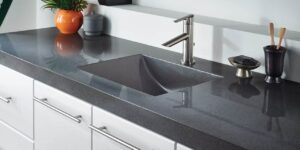You’ve spent weeks visiting showrooms, collecting samples, and finally picking the perfect stone that will become the centerpiece of your kitchen. The hard part is over, right? Not quite. Now comes the moment of truth: the estimates.
A few emails land in your inbox, and you open them with anticipation. The first one is a single, tidy number. The second is a multi-page document that looks like a complex algebraic equation. The third is somewhere in between, but the price is significantly lower than the others. Suddenly, your dream project feels overwhelming. How can you be sure you’re comparing them fairly? What’s actually included? And why is that one so cheap?
If this scenario feels familiar, you’re not alone. For many homeowners, deciphering countertop quotes is the most stressful part of a kitchen renovation. The fear of overpaying, getting hit with surprise charges, or choosing the wrong company is very real. It’s a significant investment, and you deserve to know exactly where your money is going.
This is where the power of a transparent, detailed estimate comes in. It’s more than just a piece of paper; it’s your roadmap to a successful project and your single best tool for avoiding costly mistakes. This comprehensive guide will teach you how to read, understand, and compare quotes with the confidence of an industry insider. We will provide a complete countertop estimate breakdown, explore the nuances of a granite cost comparison, and demystify the factors that drive the quartz price Orlando residents see in their bids.
By the time you finish reading, you’ll be able to spot red flags, identify true value, and choose a countertop installer who respects your budget and your home.

The Golden Rule: Why a Detailed Countertop Estimate Breakdown is Non-Negotiable
Imagine a mechanic telling you, “Fixing your car will be $1,500.” You’d immediately ask for a breakdown: How much for parts? How much for labor? What specific parts are being replaced? You wouldn’t accept a vague, lump-sum price for your car, and you absolutely shouldn’t for a project that costs thousands of dollars and is permanently installed in your home.
A single-line quote is a major red flag. It’s an opaque pricing strategy that gives all the power to the seller. They can hide inflated profit margins, use lower-quality materials, or plan to add surprise “unforeseen” charges once the work has already begun. Without a detailed list of what’s included, you have no way of knowing if you’re comparing apples to apples between different companies. That incredibly low price might not include tearing out your old counters, mounting your new sink, or even the sales tax.
Demanding a detailed countertop estimate breakdown is the first step toward a transparent and trustworthy relationship with a fabricator. It shows they are confident in their pricing and have nothing to hide. More importantly, it empowers you. You can see precisely what you are paying for, from the exact stone being used to the specific edge profile you selected. This level of detail is the foundation for making an informed, intelligent decision. Before we dive into comparing quotes, let’s first understand the essential components that should be clearly itemized on any professional estimate.
Anatomy of a Perfect Countertop Estimate: A Line-by-Line Breakdown
A professional quote is a story about your project, with every chapter detailing a crucial part of the process. Grab a quote you’ve received, and let’s walk through it together. Here are the line items you should expect to see and what they mean for your bottom line.
Line Item 1: Material Cost
This is often the largest single charge on your estimate and should be incredibly specific.
- What to Look For:
- Material Name: It should list the exact name and color of the stone (e.g., “Calacatta Laza Quartz” or “Ubatuba Granite”). Vague descriptions like “white quartz” are a warning sign.
- Brand/Manufacturer: For engineered stone, the manufacturer should be listed (e.g., Cambria, Caesarstone, Silestone). This is a key factor in the quartz price Orlando shoppers encounter.
- Grade or Level: For natural stone like granite, a grade or level (e.g., Level 1, Level 2, or Grade A, B) should be specified. This indicates the rarity and cost of the stone.
- Total Square Footage (SF): This is the total amount of material required for your project.
- Price Per Square Foot ($/SF): The cost of the material itself.
- Expert Tip: The total square footage on your quote will almost always be higher than the actual finished surface area of your countertops. This isn’t a mistake. Fabricators must purchase whole slabs from their suppliers and account for the material lost during cutting (the “kerf” of the blade) and the waste material left over after your pieces are cut out. This is called the “yield.” An efficient fabricator with advanced software can often get a better yield from a slab, potentially saving you money.
Line Item 2: Fabrication
This covers all the custom work required to transform a raw slab into your finished countertops. It’s where craftsmanship truly comes into play.
- What to Look For:
- Edge Profile: The style of the finished edge should be clearly stated. A standard “eased” or “pencil” edge is often included in the base price, while more decorative edges like Ogee, Bullnose, or a Mitered edge will add significant cost due to the complex labor involved.
- Cutouts: Every single hole needed in your countertop should be listed as a separate item. This includes the sink (specifying undermount or top-mount, as undermounts are more labor-intensive), cooktop, faucets, soap dispensers, and even electrical outlets in an island or backsplash.
- Polishing: The estimate should specify the level of polish, especially for the underside of overhangs on a breakfast bar.
- Pricing Insight: Fabrication costs are directly tied to complexity. A simple, rectangular kitchen island with one sink cutout will be far less expensive to fabricate than a large, U-shaped kitchen with a cooktop, an appliance garage, and multiple faucet holes.
Line Item 3: Tear-Out & Disposal
This covers the removal and hauling away of your old countertops.
- What to Look For: Is this service listed? Some companies include it, while others list it as an optional add-on. The quote should also specify if the cost of disposal at a landfill or recycling center is included.
- Pro-Tip: While it might be tempting to do the tear-out yourself to save a few hundred dollars, be cautious. If you accidentally damage your cabinets during removal, the repair costs could easily exceed what you would have paid the professionals. Removing tile countertops, in particular, can be a difficult job that is best left to the pros.
Line Item 4: Installation & Associated Labor
This is the cost to safely transport your fabricated countertops and expertly install them in your home.
- What to Look For:
- Standard Installation Fee: A base charge for the installation team’s time.
- Seam Details: A quality estimate may indicate how many seams your project will require and where they are likely to be placed. Fewer seams are generally better.
- Sink Mounting: If you have an undermount sink, this fee covers the labor to properly attach it to the underside of the stone with clips and epoxy.
- Sealing: For natural stones like granite and marble, the initial sealing should be included. The type of sealer used might also be specified.
- Trip Charges/Fuel Surcharges: Some companies add a fee based on your distance from their fabrication shop.
Line Item 5: Plumbing & Electrical (The Most Common “Hidden” Cost)
This is critically important. Read this section of your estimate twice.
- The Crucial Clarification: Most countertop fabricators and installers are not licensed plumbers or electricians. Their insurance will not cover them for this work.
- What to Look For: The estimate must clearly state what is—and what is not—included. Does the fee include disconnecting your old faucet and garbage disposal and reconnecting them after the new tops are in? Or does it only cover the physical act of mounting the sink bowl? If the quote says “client is responsible for all plumbing and electrical,” that is not a red flag; it is transparent. It means you will need to hire a separate plumber to come in after the counters are set to hook everything up, which is an additional cost you must budget for.
Line Item 6: Additional Fees & Taxes
The final section should clarify any remaining costs.
- What to Look For: Look for sales tax, any permit fees if required by your locality, and any other miscellaneous charges. Everything should be itemized.

The Great Debate: Granite Cost Comparison vs. Quartz Price in Orlando
Now that you understand the components of a quote, let’s talk about the biggest variable: the material itself. In the Orlando market, the two most popular choices are granite and quartz, and their pricing structures are quite different.
Granite Cost Comparison
Granite is a natural stone, and its price is determined by supply, demand, and rarity—much like precious gems. To simplify this, the industry uses a grading system, typically from Level 1 to Level 5+ (or Grade A to E).
- Level 1 (Entry-Level): This granite is abundant and features simple, consistent patterns and common colors (like Ubatuba or New Caledonia). It is quarried in huge quantities and shipped worldwide, making it highly affordable. In Orlando, you can often find Level 1 granite installed for around $45-$60 per square foot.
- Level 2-3 (Mid-Grade): Here you’ll find a wider variety of colors and more movement or veining in the stone. These slabs are less common than Level 1. Prices in this range can be anywhere from $60-$90 per square foot.
- Level 4-5+ (Exotic): This is high-end, rare granite. The colors are striking, the patterns are unique, and the slabs often come from exclusive or hard-to-access quarries in places like Brazil or Italy. These are statement pieces, and their price reflects their rarity, often starting at $100 per square foot and going well beyond $200.
When performing a granite cost comparison, ensuring you are being quoted for the same level of stone is paramount. A quote for “Level 1” granite will always be cheaper than one for “Level 3,” even if the fabrication and installation costs are identical.
Quartz Price Orlando
Quartz is an engineered product, and its price is driven by the manufacturer’s brand reputation, the complexity of the design, and the technology required to produce it.
- Brand is King: Premium, American-made brands like Cambria often carry a higher price tag due to their marketing, extensive warranties, and brand recognition. Well-regarded international brands like Silestone and Caesarstone also sit at the higher end. There are many other newer or less-marketed brands that offer excellent quality at a more competitive price point.
- Complexity of Design: A simple, solid white or single-color quartz is the least expensive to manufacture. The price increases as you add more complexity. Designs that artfully mimic the intricate veining of rare Italian marble are the most expensive, as they require advanced manufacturing processes and artistry to look realistic.
- Orlando Market Pricing: The quartz price Orlando homeowners can expect generally starts around $60-$75 per square foot for entry-level designs from reputable brands. For more complex, marble-look designs from premium manufacturers, prices can easily climb to $110-$150+ per square foot.
The key takeaway is that you cannot simply assume “granite is cheaper than quartz.” A high-end, exotic granite will be far more expensive than a basic, entry-level quartz. The only way to truly compare is to have a specific stone of each type quoted on a detailed estimate.
How to Compare Apples to Apples: A Checklist for Reviewing Multiple Bids
You’ve done the hard work of getting detailed quotes. Now, lay them out side-by-side and use this checklist to perform a true, fair comparison.
- [ ] Material Match: Are all quotes for the exact same material? Check the granite name and level, or the quartz brand and color name.
- [ ] Square Footage: Are the square footage calculations similar across all bids? A major difference of more than a few square feet could indicate a measurement error on one company’s part.
- [ ] Edge Profile: Is the same edge profile (e.g., “eased,” “ogee”) listed on each? A fancier edge on one quote will raise its price.
- [ ] All Cutouts Included?: Make a list of every cutout you need (sink, cooktop, etc.) and check it off against each estimate. A missing cutout is a future charge waiting to happen.
- [ ] Scope of Work: Does each quote include the same services? Create columns for Tear-Out, Disposal, Sink Mounting, and Sealing. Check off which company includes each service in their base price. This is often where a “cheaper” quote reveals its hidden costs.
- [ ] Plumbing Responsibility: Who is handling the plumbing? Be crystal clear on this. If one quote is $300 cheaper but doesn’t include plumbing disconnect/reconnect, you’ll likely spend that and more hiring your own plumber.
- [ ] Company Reputation: Look beyond the numbers. Check online reviews on Google. How long have they been in business? Do they have a physical showroom and fabrication shop you can visit? A well-established company with a solid warranty and happy customers might be worth a small premium over a newer, unproven competitor.
Red Flags & Hidden Costs: Don’t Get Blindsided
As you review your estimates, keep an eye out for these common red flags:
- Lump-Sum Pricing: As discussed, a lack of detail is a major warning.
- High-Pressure Sales Tactics: A reputable company will give you time to review their quote. Be wary of any offer that is “only good for today.”
- Vague Material Descriptions: If the quote says “Group A Granite” without a specific stone name, you don’t know what you’re actually getting.
- An Unbelievably Low Price: If one price is drastically lower than all the others, be suspicious, not excited. It could mean they’re using a lower-grade material, their measurements are wrong, or they plan to add charges later. Quality materials and skilled labor cost money.
Conclusion: From Confused to Confident
Choosing new countertops is a major, exciting upgrade for your home. By taking the time to understand the estimate process, you transform it from a point of stress into a position of strength. A detailed quote is your best defense against surprises and your clearest path to finding exceptional value.
You are now fully equipped to demand a transparent countertop estimate breakdown, conduct an intelligent granite cost comparison, and accurately analyze the quartz price Orlando fabricators are offering. Use this knowledge to ask pointed questions, compare your options with clarity, and choose a countertop partner who will bring your vision to life, on budget and with the quality craftsmanship your home deserves.




